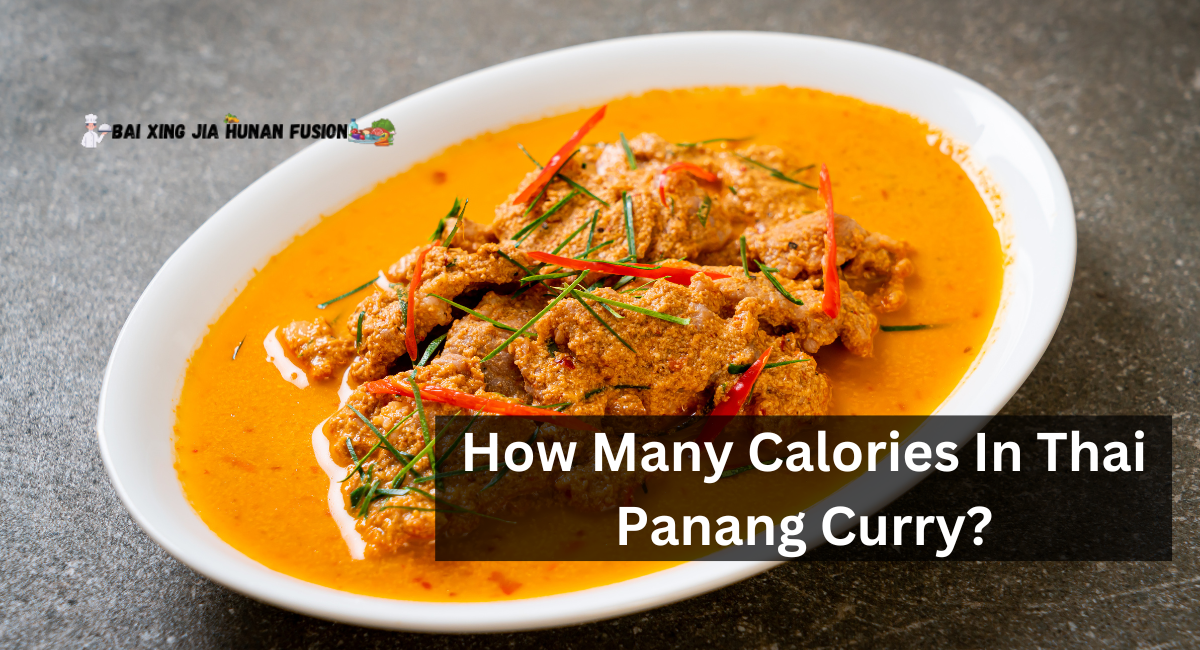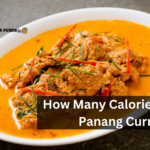If you’re a devotee of Thai food, you’ve probably tasted the rich and flavorful Panang Curry. This luscious and aromatic dish is a worldwide favorite among foodies. However, if you’re mindful of your calorie consumption, you might ponder how many calories are packed into this mouthwatering delight.
In this article, we will explore the How many Calories in Panang Curry, providing an in-depth analysis of its caloric content and other vital nutrients.
What Is Thai Panang Curry?
Panang Curry, also called Penang Curry, is a well-known Thai curry that originated in the Penang region of Malaysia. This curry is distinguished from other Thai curries by its unique combination of Thai and Malaysian flavors. It is well-known for its velvety texture, moderate spiciness, and ideal sweet and savory flavor balance.
Ingredients:
For Curry Paste, combine:
- Add 2 to 3 desiccated red chilies, depending on your desired heat level.
- Two shallots coarsely minced.
- 3 garlic stalks
- One inch of galangal (or ginger).
- One thinly cut lemongrass stalk
- Optional one leaf of kaffir lime
- One teaspoon of shrimp paste (or fish sauce if you’re vegetarian)
As for the Curry:
- 2 tablespoons of liquid vegetable oil
- 1-2 tablespoons of Panang curry paste (to flavor).
- One kilogram of your choice of chicken, beef, tofu, or seafood.
- Fourteen ounces (one can) of coconut milk.
- One thinly cut red pepper
- 1 gallon of Thai basil leaves
- Two tablespoons of palm sugar (or brown sugar) melted.
- Two tablespoons of fish sauce (or soy sauce for a vegetarian alternative)
- salt to taste
Cooking Instructions:
Step 1: Prepare the Curry Paste
In a mortar and pestle, mash together the dried red chilies, shallots, garlic, galangal, lemongrass, kaffir lime leaf (if using), and shrimp paste until a homogeneous paste forms.
Step 2: Cook the Curry
- Heat the oil in a big pan over medium heat.
- Stir-fry the paste for one to two minutes or until it smells good.
- Add the protein you choose (chicken, beef, tofu, or shrimp) and simmer until no longer pink or translucent.
- Pour coconut milk into the pan and turn the heat down to a boil.
- Add the sliced red bell pepper and let the sauce simmer for 5–7 minutes or until the pepper is soft.
- Palm sugar, fish sauce, and sodium flavor the curry. Adjust the seasonings to your taste.
- Add the Thai basil leaves to the curry and stir them in until they wilt.
Step 3: Serve and delight
Your domestic Panang Curry is prepared to be consumed. For a comprehensive Thai dining experience, serve it hot over steamed jasmine rice.
How Many Calories In Panang Curry?
A normal Panang Curry serving, about 1 cup (240 grams), contains 350 to 450 calories. However, the exact number of calories can vary based on things like the size of the serving and the type of protein used. The biggest sources of calories are coconut milk (150–200 calories), protein (150–250 calories), red curry paste (30–50 calories), and veggies (about 20–30 calories). It’s important to remember that these numbers are estimates and may change depending on the recipe and items used.
Panang Curry’s Health Benefits
Here are some health benefits :
- Rich in Nutrients: Panang Curry includes a colorful assortment of vegetables, including bell peppers, carrots, and green beans, as well as herbs, such as Thai basil and kaffir lime leaves. These ingredients contain a variety of essential vitamins and minerals. For example, vitamin C from bell peppers strengthens the immune system, whereas vitamin A from carrots promotes healthy vision. Additionally, abundant in these vegetables, potassium plays a crucial role in maintaining blood pressure and overall cardiovascular health.
- Healthy Fats: The luscious, creamy base of Panang Curry, derived from coconut milk, is a source of healthy fats. Coconut milk contains medium-chain triglycerides (MCTs), which are simpler for the body to digest and provide instant energy. These healthy fats are also associated with enhanced cardiovascular health and can aid in weight management when consumed in moderation.
- Protein Source: When it comes to protein sources, Panang Curry is adaptable. You may select from lean chicken breast, tofu, shellfish, or beef to accommodate your dietary preferences. Protein is important for muscle maintenance and growth; consuming it can help you feel full and satiated.
- Spices and Antioxidants: The crimson curry paste in Panang Curry contains a blend of spices, including chili peppers and ginger. These spices are abundant in antioxidants, which can combat oxidative stress and inflammation within the body. Red chili peppers contain capsaicin, a compound with various health advantages, including pain relief and a boosted metabolism.
- Digestive Benefits: Some ingredients in Panang Curry, such as lemongrass and kaffir lime leaves, are well-known for their digestive benefits. Lemongrass, in particular, has been traditionally employed to ameliorate digestive issues and may provide a refreshing and soothing effect on the stomach.
- Flavorful Alternative: One of the primary advantages of Panang Curry is that it provides a healthier and more flavorful alternative to less nutritious takeout options. Its vibrant flavor, derived from a harmonious blend of herbs and spices, can satiate your cravings while allowing you to maintain a healthy diet. By choosing Panang Curry over heavily processed or fatty fast food, you can satiate your hunger without compromising your health goals.
Thanks for visiting our site hope you like it..










